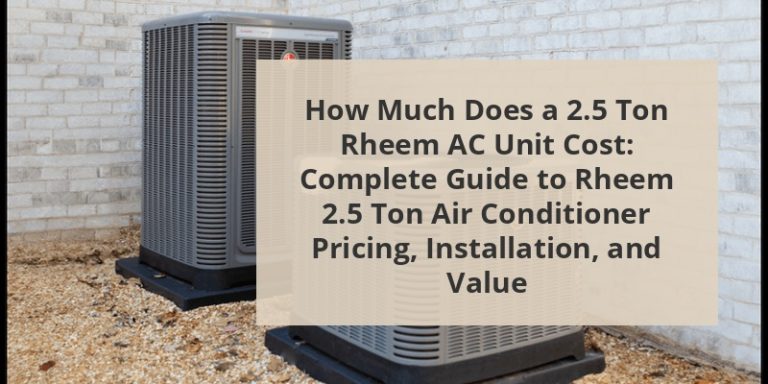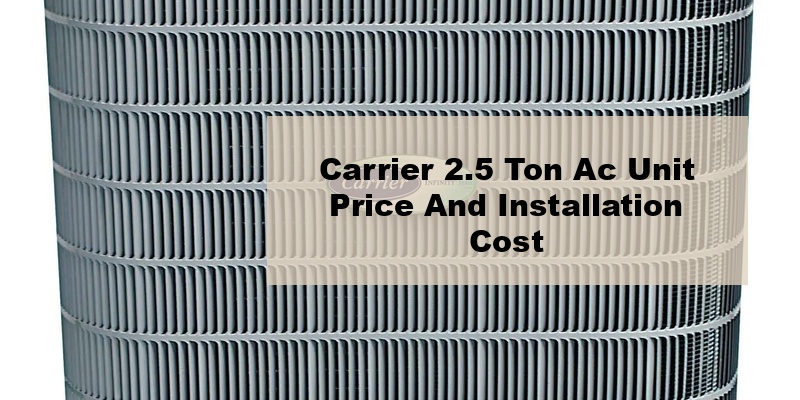How Much For A 2.5 Ton Ac Unit Installed

Navigating the world of HVAC systems can feel overwhelming, especially when you’re trying to balance upfront costs with long-term energy savings. If you’re considering a 2.5 ton AC unit – a common size for smaller homes and apartments – understanding the installation costs and factors influencing them is crucial. This guide breaks down the expenses associated with a 2.5 ton AC unit installation, helps you identify opportunities for savings, and explores the benefits of integrating smart technology to optimize your energy usage.
Understanding the Base Cost: A Breakdown
The cost of a 2.5 ton AC unit installation generally ranges from $3,500 to $7,000. This broad range reflects several variables, including the unit’s efficiency rating, brand, installation complexity, and local labor costs. Let’s dissect these contributing factors:
The Unit Itself
The AC unit is the most significant expense. Prices vary widely based on the SEER (Seasonal Energy Efficiency Ratio) rating. A higher SEER rating indicates greater energy efficiency, translating to lower electricity bills over the system's lifespan. Energy Star recommends a minimum SEER of 15 for central air conditioners in warmer climates and 14 in cooler regions. Expect to pay more upfront for a unit with a SEER rating of 16 or higher, but remember that this investment can yield substantial long-term savings.
For example, a basic 2.5 ton AC unit with a SEER of 14 might cost around $2,000, while a high-efficiency unit with a SEER of 18 or higher could easily exceed $3,500. Investing in a higher SEER unit can significantly reduce your carbon footprint and energy bills over the lifespan of the AC system.
Installation Costs
Labor costs constitute a significant portion of the total installation expense. Complex installations involving ductwork modifications, electrical upgrades, or challenging access points will naturally increase labor charges. Always obtain multiple quotes from licensed and insured HVAC contractors to ensure competitive pricing. Expect installation costs to range from $1,500 to $3,500, depending on the complexity of the job and your location.
Factors impacting installation costs include:
- Existing Ductwork: If your existing ductwork is in good condition and properly sized, the installation will be simpler and less expensive. Damaged or undersized ductwork may require repairs or replacement, adding to the overall cost.
- Electrical Work: Older homes may require electrical upgrades to accommodate the new AC unit's power requirements. This can involve installing a new circuit breaker or upgrading the electrical panel.
- Permits and Inspections: Most jurisdictions require permits for HVAC installations. The contractor will typically handle the permitting process, but the cost of the permit is usually passed on to the homeowner. Inspections are also required to ensure the installation meets local building codes.
- Accessibility: Difficult access to the installation site can increase labor costs. For example, if the AC unit needs to be installed on a rooftop or in a crawl space, the contractor may need to use specialized equipment or take extra precautions, which can add to the time and expense.
Beyond the Basics: Additional Costs to Consider
While the unit and installation comprise the bulk of the cost, several other factors can influence the final price:
Smart Thermostats and Sensors
Integrating smart thermostats and sensors can significantly enhance your AC system's energy efficiency. These devices allow you to remotely control your thermostat, set customized schedules, and monitor your energy usage in real-time. Many smart thermostats also learn your preferences and automatically adjust the temperature to optimize comfort and savings. Expect to pay between $100 and $300 for a smart thermostat, plus installation costs.
Smart sensors placed throughout your home can provide granular temperature readings, allowing the smart thermostat to adjust airflow to different zones, further optimizing energy efficiency. This targeted cooling can lead to substantial savings, especially in larger homes.
Ductwork Cleaning and Sealing
Leaky or dirty ductwork can significantly reduce your AC system's efficiency. Consider having your ductwork cleaned and sealed to improve airflow and prevent energy loss. Duct cleaning typically costs between $300 and $700, while duct sealing can range from $500 to $1,500, depending on the extent of the leaks.
Air Purifiers and Filtration Systems
If you suffer from allergies or respiratory issues, you might consider adding an air purifier or advanced filtration system to your HVAC system. These systems can remove dust, pollen, pet dander, and other allergens from the air, improving indoor air quality. Prices range from $200 to $1,000, depending on the type and features of the system.
Maximizing Savings: Rebates, Tax Credits, and Energy Efficiency
Numerous incentives are available to help offset the cost of installing a high-efficiency AC unit. These include:
Federal Tax Credits
The federal government offers tax credits for energy-efficient home improvements, including HVAC systems. The specific credits available and their amounts vary from year to year, so consult the Energy Star website or a qualified tax professional for the latest information. These credits can significantly reduce your overall investment in a new, efficient AC unit.
State and Local Rebates
Many states and local utility companies offer rebates for installing energy-efficient appliances, including AC units. These rebates can range from a few hundred dollars to several thousand dollars, depending on the unit's efficiency and your location. Check with your local utility company and state energy office to see what rebates are available in your area. Database of State Incentives for Renewables & Efficiency (DSIRE) is a great resource.
Energy-Efficient Financing
Some lenders offer specialized financing options for energy-efficient home improvements. These loans often have lower interest rates and longer repayment terms, making it easier to afford a high-efficiency AC unit. Look for programs offered by your local utility company or credit unions specializing in green lending.
Choosing the Right Contractor: Essential Considerations
Selecting a qualified and reputable HVAC contractor is crucial for a successful installation. Consider the following factors:
- Licensing and Insurance: Ensure the contractor is properly licensed and insured to protect yourself from liability in case of accidents or property damage.
- Experience and Expertise: Choose a contractor with experience installing similar AC units and a proven track record of quality workmanship.
- References and Reviews: Check online reviews and ask for references from past customers to gauge the contractor's reputation.
- Written Estimates: Obtain detailed written estimates from multiple contractors, outlining the scope of work, materials, and labor costs.
- Warranty: Ensure the contractor offers a warranty on their workmanship, in addition to the manufacturer's warranty on the AC unit.
Smart Home Integration: Taking Control of Your Cooling
Integrating your new 2.5 ton AC unit with a smart home system can further optimize energy efficiency and enhance comfort. Here are some benefits of smart HVAC integration:
- Remote Control: Control your thermostat from anywhere using your smartphone or tablet.
- Automated Scheduling: Set customized schedules to automatically adjust the temperature based on your daily routine.
- Geofencing: Use geofencing to automatically turn down the AC when you leave home and turn it back on when you return.
- Energy Monitoring: Track your energy usage in real-time and identify opportunities to save money.
- Voice Control: Control your thermostat using voice commands with compatible smart home devices like Amazon Echo or Google Home.
Is a 2.5 Ton AC Unit Right for You?
Determining the appropriate AC unit size is crucial for optimal performance and energy efficiency. An undersized unit will struggle to cool your home, while an oversized unit will cycle on and off frequently, leading to energy waste and reduced lifespan. A 2.5 ton AC unit is typically suitable for homes ranging from 1,200 to 1,500 square feet, depending on factors such as climate, insulation, and window size. A professional HVAC contractor can perform a load calculation to determine the precise size of AC unit required for your home.
Long-Term Value and ROI
While the upfront cost of a new 2.5 ton AC unit installation can seem significant, it's essential to consider the long-term value and return on investment. A high-efficiency AC unit can significantly reduce your energy bills, saving you hundreds or even thousands of dollars over its lifespan. Additionally, a properly installed and maintained AC system can improve your home's comfort and indoor air quality, enhancing your overall quality of life.
By carefully considering all the factors outlined in this guide and taking advantage of available rebates and incentives, you can make an informed decision about your 2.5 ton AC unit installation and maximize your energy savings.










